The Clouds over Amsterdam
Clare Bucknell
In marine painting of the Dutch Golden Age, weather isn’t merely a backdrop. Skies are characterful, vehicles for drama and mood. Dark clouds, towering above ships, may be warnings; windless air and slack sails can suggest calm, exhaustion or frustration. But weather is also an opportunity for verisimilitude. From the 1630s, according to a recent piece of meteorological analysis, artists became more interested in rendering observable cloud formations, rather than the generic, puffy shapes their predecessors had relied on. They reproduced conditions they saw for themselves on the North Sea coast.
Accuracy in depicting wind and water, indicating firsthand experience of seafaring, was a point of pride. Hendrick Cornelisz Vroom advertised that he had survived shipwreck off the coast of Portugal. Willem van de Velde the Elder included himself in his pen-and-ink Battle of Scheveningen (1655). He appears as a minuscule, behatted figure, clutching his sketching block and pencil in a small boat. The details his picture captures, this touch tells us, couldn’t have been recorded from the safety of the shore.
The outsize power of the Dutch Republic during the 17th century depended on ships and sailors. Its commercial wealth came from the sea, accumulated through European maritime trade and control of colonial supply routes. It displayed its might at sea, defending trading posts in pitched battles with the English, French, Spanish and Portuguese navies. Its domestic art market tracked these interests. Commercially prosperous Dutchmen and women – merchants, shipbuilders, bankers and their families – followed the aristocracy in self-advertising through artistic commissions. They favoured marine subjects, compositions that celebrated the sites and means of their good fortune: seascapes, harbour scenes, stormy rescues, naval battles.
Details in marine paintings are often metonyms for larger, abstract concepts beyond the bounds of the picture. A Dutch flag billows from the topmost mast of a warship in Reinier Nooms’s Amsterdam Harbour Scene (c.1654-55, above), foregrounded to appear larger than the sails of the ships behind it. In Willem van de Velde the Younger’s Calm: Dutch Ships Coming to Anchor (c.1665, top) there are flashes of gold, reminders that naval power and money go hand-in-hand: one vessel has a gilt-painted coat of arms; the lion figurehead on the stempost of another sports a curly golden mane.
Weather can be read in this way, understood through a set of shared associations: storms bad, sunbeams good. The more interesting marine paintings treat it as a subject in its own right. Vroom’s A Dutch Ship and a Kaag in a Fresh Breeze (c.1628-30), depicting a warship and a smaller boat on the move, is as much about winds and their effects as ships. Fine wavy lines in Vroom’s clouds, running laterally across the picture, tug them into motion. The same lines reproduced below, delicate swoops and troughs in the water, show the sea racing in the same direction, throwing up little clouds of spume.
In paintings of stillness rather than motion, atmosphere becomes the subject. In Abraham de Verwer’s View of Hoorn (c.1650), a depiction of the coast north of Amsterdam, the ships’ slack sails show that nothing is moving. Interest, in the vast sky, comes from small differences in the weight of the air: between patches of pure transparent blue, wispy trailing clouds and heavier-looking cumulus formations.
Pictures with a narrative element make weather part of their storytelling. Van de Velde the Younger’s Dutch Fleet Assembling Before the Four Days’ Battle of 11-14 June 1666 (1670) depicts warships in formation ahead of one of the bloodier conflicts of the Second Anglo-Dutch War. The grand vessel in the foreground, the Liefde, is plunged in shadow, its frail-looking masts and rigging near-enveloped by a thick, dark cloud mass. The ship went down in the battle, with a loss of 1500 men.
In Ludolf Backhuysen’s Ships in Distress off a Rocky Coast (1667), the drama is immediate rather than foreshadowed. Three cargo ships, all missing a mast, lurch at alarming angles on high waves. The opaque, queasy-looking tone of the water is repeated in the solid grey cloud structures above. Rocks jut out like teeth in the foreground. The weather points in two directions at once. One ending to the story is suggested by the swirling cloud mass, the pieces of flotsam already in the water, the men who seem poised to jump. Another is indicated by the top corner of the picture, where a patch of warm yellow sky, lit from behind by sunbeams, may signal the storm’s abatement.
One reason the weather is such a reliable topic of conversation is its temporariness. Clouds move, winds change, rain comes and goes; there’s always something to talk about. (According to my Dutch partner, one of the things the Dutch think they’re known for is complaining about the weather.) In paint, the temporary is hard to capture. ‘Day after day, day after day,/We stuck, nor breath nor motion;/As idle as a painted ship/Upon a painted ocean,’ Coleridge’s Ancient Mariner says, using the fixity of art as a simile for immobility.
Golden Age painting does its best to depict the contingent aspects of weather. In Simon de Vlieger’s Estuary at Day’s End (c.1640-45), smoke drifts with the wind, and a workman takes his chance to re-tar a hull before the light fades. But most artists of the period prefer weather’s providential aspect, the way it can be harnessed to express certainty or teleology. Behind de Vlieger’s workman toiling on the shore, and behind the fleet of ships visible in the estuary in the distance, crepuscular rays of sunlight emerge from the clouds like divine arrows. In van der Velde the Younger’s After the Storm (c.1700, below), another sunset composition, the louring, gunmetal sky dominates the picture. The ships in the foreground seem lucky to have made it through intact. But fingers of light, extending from the far corner and pointing down to the vessels, indicate the source of their good fortune. If Dutchmen survived at sea, it was because they had something bigger than weather on their side.
This piece is part of the LRB’s collaboration with the World Weather Network.

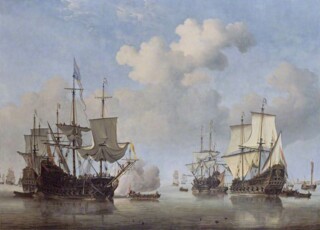
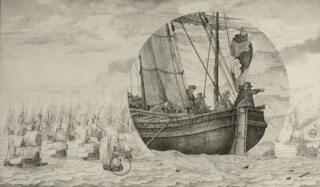
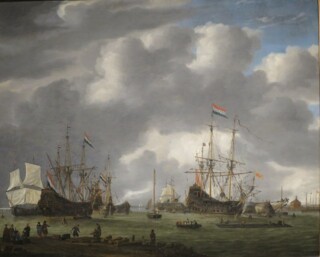
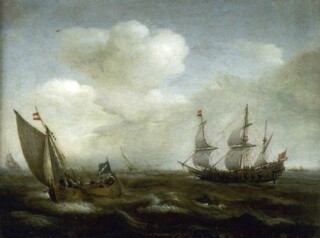
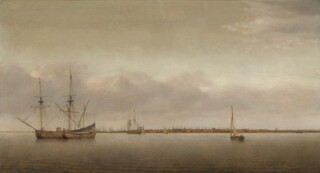
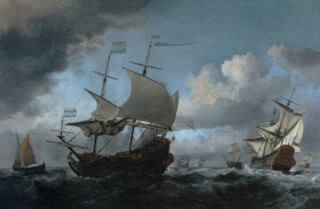
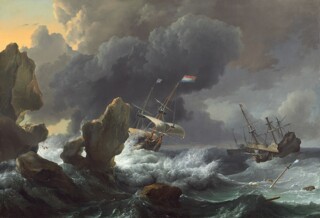
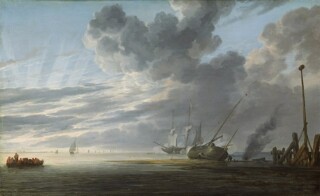
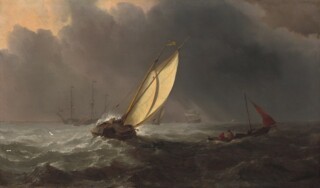
Comments